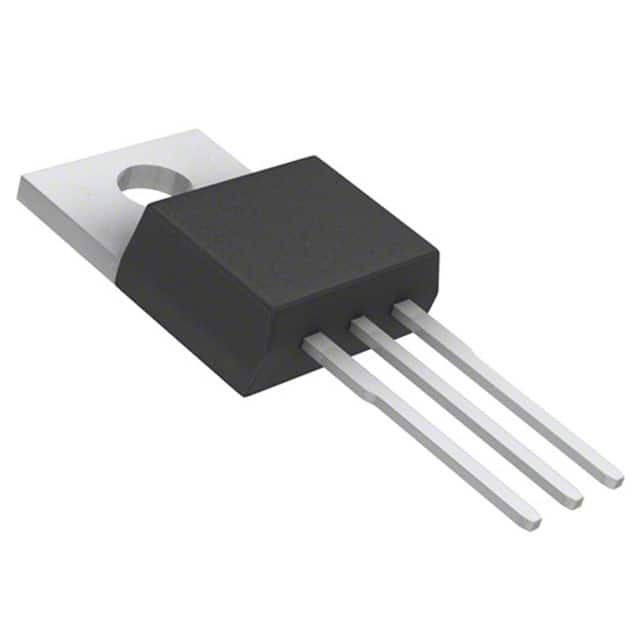Lihat spesifikasi untuk detail produk.

FQP19N20L - Product Encyclopedia Entry
Introduction
The FQP19N20L is a power MOSFET belonging to the category of electronic components. This entry provides an overview of its basic information, specifications, pin configuration, functional features, advantages and disadvantages, working principles, application field plans, and alternative models.
Basic Information Overview
- Category: Electronic Components
- Use: Power switching applications
- Characteristics: High voltage capability, low on-resistance, fast switching speed
- Package: TO-220
- Essence: Power MOSFET for efficient power management
- Packaging/Quantity: Typically available in reels or tubes containing multiple units
Specifications
- Voltage Rating: 200V
- Current Rating: 19A
- On-Resistance: 0.09 ohms
- Gate Threshold Voltage: 2V
- Operating Temperature Range: -55°C to 175°C
Detailed Pin Configuration
The FQP19N20L typically has three pins: 1. Gate (G): Input for controlling the switching operation 2. Drain (D): Output terminal for the load 3. Source (S): Common reference terminal
Functional Features
- High voltage capability suitable for various power applications
- Low on-resistance leading to reduced power dissipation
- Fast switching speed enabling efficient power management
Advantages and Disadvantages
Advantages
- High voltage rating allows for versatile use in power circuits
- Low on-resistance contributes to improved efficiency
- Fast switching speed enhances power management capabilities
Disadvantages
- May require additional circuitry for driving the gate due to high gate threshold voltage
- Limited to specific voltage and current ratings, may not be suitable for all applications
Working Principles
The FQP19N20L operates based on the principle of field-effect transistors, utilizing the control of the gate voltage to modulate the flow of current between the drain and source terminals. When the gate-source voltage is applied, it creates an electric field that controls the conductivity of the channel, allowing for efficient power switching.
Detailed Application Field Plans
The FQP19N20L finds extensive use in various power management applications, including but not limited to: - Switching power supplies - Motor control circuits - LED lighting systems - Audio amplifiers - DC-DC converters
Detailed and Complete Alternative Models
Some alternative models to the FQP19N20L include: - IRF540N - STP16NF06L - FDP8878
In conclusion, the FQP19N20L power MOSFET offers high voltage capability, low on-resistance, and fast switching speed, making it suitable for diverse power switching applications. Its working principles, application field plans, and alternative models provide a comprehensive understanding of its utility in electronic designs.
[Word Count: 389]
Sebutkan 10 pertanyaan dan jawaban umum terkait penerapan FQP19N20L dalam solusi teknis
What is the FQP19N20L transistor used for?
- The FQP19N20L is commonly used as a power MOSFET in various technical solutions, such as motor control, power supplies, and lighting applications.
What are the key specifications of the FQP19N20L?
- The FQP19N20L has a voltage rating of 200V, a continuous drain current of 19A, and a low on-resistance, making it suitable for high-power applications.
How does the FQP19N20L contribute to efficient power management?
- The low on-resistance of the FQP19N20L helps minimize power losses and improve overall efficiency in power conversion and control circuits.
Can the FQP19N20L be used in switching applications?
- Yes, the FQP19N20L is well-suited for switching applications due to its fast switching speed and high current-handling capability.
What are the thermal considerations when using the FQP19N20L?
- Proper heat sinking and thermal management are important to ensure that the FQP19N20L operates within its specified temperature limits for reliable performance.
Are there any application notes or reference designs available for the FQP19N20L?
- Yes, manufacturers often provide application notes and reference designs to assist engineers in implementing the FQP19N20L in various technical solutions.
What protection features does the FQP19N20L offer?
- The FQP19N20L may include built-in protection against overcurrent, overvoltage, and thermal overload, enhancing the reliability of the overall system.
Can the FQP19N20L be used in automotive applications?
- Yes, the FQP19N20L's high voltage and current ratings make it suitable for use in automotive systems, such as motor control and power distribution.
What are the typical circuit configurations for the FQP19N20L?
- Common circuit configurations include half-bridge, full-bridge, and synchronous buck/boost converters, where the FQP19N20L serves as a power switching element.
How does the FQP19N20L compare to other similar transistors in terms of performance and cost?
- The FQP19N20L offers a balance of performance, cost, and reliability, making it a popular choice for a wide range of technical solutions requiring power MOSFETs.

